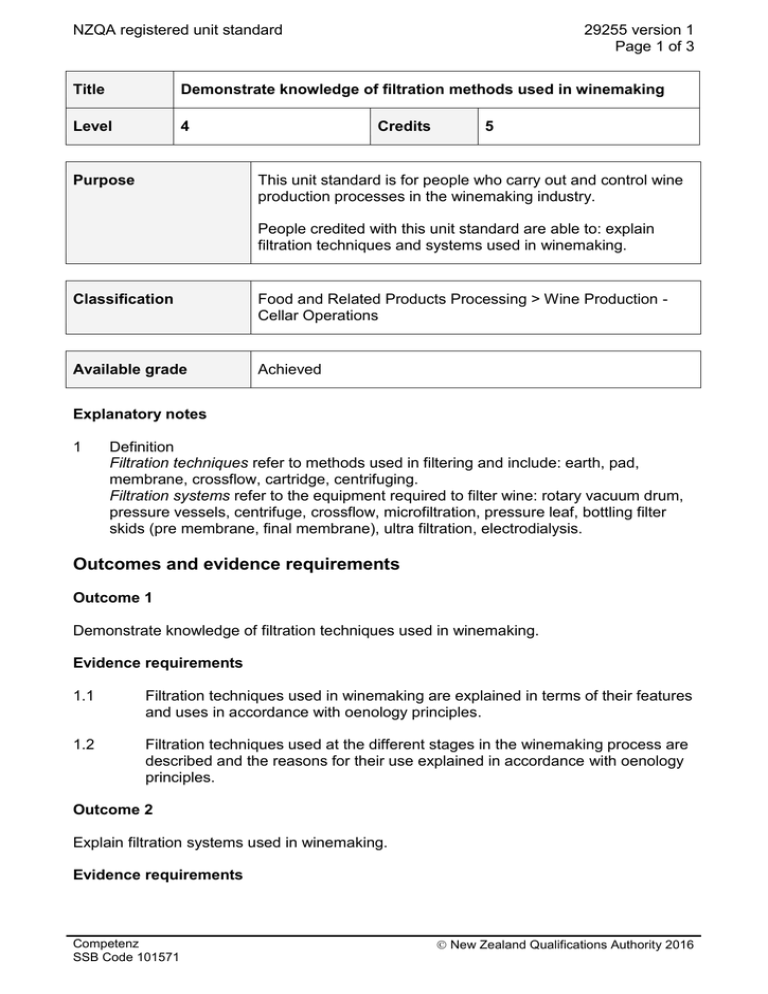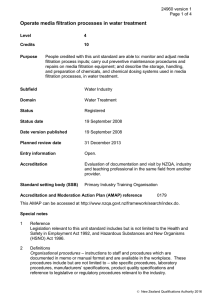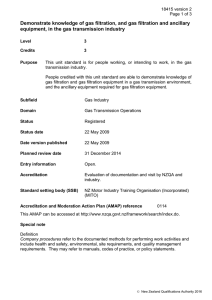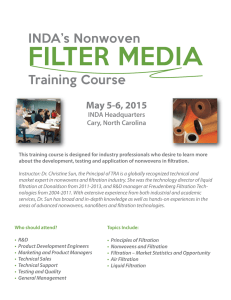NZQA registered unit standard 29255 version 1 Page 1 of 3
advertisement

NZQA registered unit standard 29255 version 1 Page 1 of 3 Title Demonstrate knowledge of filtration methods used in winemaking Level 4 Purpose Credits 5 This unit standard is for people who carry out and control wine production processes in the winemaking industry. People credited with this unit standard are able to: explain filtration techniques and systems used in winemaking. Classification Food and Related Products Processing > Wine Production Cellar Operations Available grade Achieved Explanatory notes 1 Definition Filtration techniques refer to methods used in filtering and include: earth, pad, membrane, crossflow, cartridge, centrifuging. Filtration systems refer to the equipment required to filter wine: rotary vacuum drum, pressure vessels, centrifuge, crossflow, microfiltration, pressure leaf, bottling filter skids (pre membrane, final membrane), ultra filtration, electrodialysis. Outcomes and evidence requirements Outcome 1 Demonstrate knowledge of filtration techniques used in winemaking. Evidence requirements 1.1 Filtration techniques used in winemaking are explained in terms of their features and uses in accordance with oenology principles. 1.2 Filtration techniques used at the different stages in the winemaking process are described and the reasons for their use explained in accordance with oenology principles. Outcome 2 Explain filtration systems used in winemaking. Evidence requirements Competenz SSB Code 101571 New Zealand Qualifications Authority 2016 NZQA registered unit standard 29255 version 1 Page 2 of 3 2.1 The utilisation of filtration techniques in different filtration systems is explained in accordance with oenology principles. 2.2 Operating principles of filtration systems are explained in accordance with manufacturer’s documentation. Range 2.3 evidence is required of three systems. Operating parameters and capability of filtration systems are explained in accordance with manufacturer’s documentation. parameters may include but are not limited to – turbidity pre and post filtration, pore size, flow rates, pressure range, filterability index. Range 2.4 Operating components and process controls used in filtration systems are identified, and their purpose and operation are explained, in accordance with manufacturer’s documentation. 2.5 Preparation of filtration system components is described in accordance with manufacturer’s documentation. 2.6 Consequences of incorrect or insufficient filtration are explained in accordance with oenology principles. 2.7 The quality control parameters used for filtration systems are explained in accordance with oenology principles. quality control parameters may include but are not limited to – pressure, temperature, filtration flowrate, sulphur dioxide measurement, turbidity, filterability index. Range Planned review date 31 December 2019 Status information and last date for assessment for superseded versions Process Version Date Last Date for Assessment Registration 1 19 November 2015 N/A Consent and Moderation Requirements (CMR) reference 0013 This CMR can be accessed at http://www.nzqa.govt.nz/framework/search/index.do. Please note Providers must be granted consent to assess against standards (accredited) by NZQA, before they can report credits from assessment against unit standards or deliver courses of study leading to that assessment. Industry Training Organisations must be granted consent to assess against standards by NZQA before they can register credits from assessment against unit standards. Competenz SSB Code 101571 New Zealand Qualifications Authority 2016 NZQA registered unit standard 29255 version 1 Page 3 of 3 Providers and Industry Training Organisations, which have been granted consent and which are assessing against unit standards must engage with the moderation system that applies to those standards. Requirements for consent to assess and an outline of the moderation system that applies to this standard are outlined in the CMRs. The CMR also includes useful information about special requirements for organisations wishing to develop education and training programmes, such as minimum qualifications for tutors and assessors, and special resource requirements. Comments on this unit standard Please contact Competenz at qualifications@competenz.org.nz if you wish to suggest changes to the content of this unit standard. Competenz SSB Code 101571 New Zealand Qualifications Authority 2016





